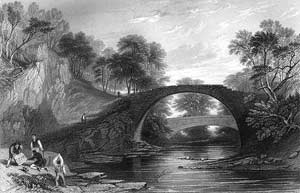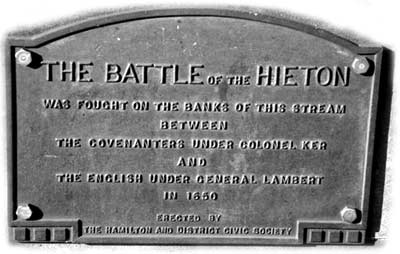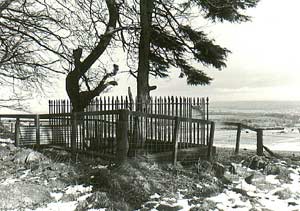|
by Thomas Reid
PSAS February 1913
Extract 1
In 1649 the magistrates of the Burgh of Lanark suppicated the Scottish parliament for aid in building a bridge at Clydesholm.......... .......They are however unable to undertake the burden of building such a bridge in consequence of the impoverished state of their burgh arising from:
(1)"The pestilence" (ie the plague of 1645, when whole families perished in Lanark);
(2) "The spoyeling and plundering in breking up of their houses by that wicked armie under command of James Grahame" (ie the Marquis of Montrose; it was the time of Philiphaugh);
(3) "The laite unlaufull ingagement" (ie the secret treaty between commissioners from the Scottish Parliament and King Charles made in the Isle of Wight);
............... ......But although parliament promptly granted the required sanction and the presbytery actively favoured the proposal, the matter appears to have gone no further at this time, doubtless on account of the disturbed conditions of the Lowlands during Cromwells campaigns, and in the subsequent period form 1660 to 1688 - the time of religous and political persecution.
Extract 2
Ford and Ferry at Crossford.
In 1650, during the closing days of a very wet November, a detachment of Cromwells Ironsides passed through this ford. The force consisted of 4000 troopers under the command of Major General Lambert, who was under orders from Cromwell to march from Peebles, and, getting to the south side of the Clyde, to act in concert with the army under Cromwell proceeding from Edinburgh towards the north bank of the river, the object being to make a simultaneous attack on the Covenanting forces under Strachan and Kerr (Western association forces, circa 1000 strong) , in leaguer at Carmunnock.
In setting out from Peebles Lambart would direct his march along the right bank of the Clyde. The river was then in spate, and the usual route from Biggar to Lanark, necessitating the crossing of the river by ford at two points, Thankerton and Carmichael, would be dangerous.
As it was, the troopers on arriving at Lanark on Thursday 28th November were compelled by the continued wet weather to delay their march to the Saturday of that week. Meanwhile on the said Thursday Cromwell had arrived, by way of Shotts, at or near Holytown; but partly from exaggerated reports of the Coveanters strength, and partly from the opinion that the Major General would not come "By reason of the waters" marched back at seven o`clock on Friday morning to Edinburgh.
 At the moment when Lambert entered Lanark, the presbytery of the bounds was in session, unaware of the approach of the enemy. "Mr John Hume of Lesmahagow" so runs the presbytery minute "did exercise, as he was ordained, but the brethern got not libertie to sit doun in presbyterie, because, immediatelie after exercise, the enemy came to the toun of Lanarke, being about the number of four thousand, and so were forced to goe away in haste out of the toune; and the said horses staid in the said toune of Lanarke till the Saturday in the morning and then went to Hamiltoun".
Probably by that time the waters had somewhat subsided. The route to Hamilton did not then as now lead across Clyde at Clydesholm Ford - there was then no bridge; nor as now, was there a road along the left bank of the Clyde in the parish of Lesmahagow. The road to Hamilton in 1650 crossed the Mouse water near its confluence with Clyde, proceeded onward over Nemphlar Brae, with Lee place (now castle) on the right, and so down to crossford, four miles below Lanark.
Here there was both a ford and a ferry which gave a safer passage on account of the greater breadth of river.
On crossing the ford Lamberts troopers had now got as ordered onto the south side of the Clyde, and would soon reach Hamilton.
 Next morning, being the "Lords day" the bugle call for resuming the march had sounded about half past three; and so the troopers, all unwitting of Kerrs surprise assault delivered half an hour later, were nevertheless fuly prepared for battle.
The fight was a grim affair (known locally as the battle of Hietoun) fought in that dark December morning in the streets and ditches of Hamilton, and ended in the discomfiture of the Coveanters and the capture of Colonel Kerr (who was wounded).
Extract 3
In the year 1666 the Lanark ford and ferry were the scene of an unusual commotion - the insurgents of the Pentland Rising on their way from Dumfries to Rullion Green here crossed the water of Clyde.
They had entered Lanarkshire by way of Cumnock and Muirkirk, having diverted their march towards Glasgow on hearing that Dalzeil at the head of the government forces was at Mauchline. They were allured to Clydesdale - as they were a day or two later to the Lothians- by the hope of gaining recruits to their cause.
Douglas was reached by nightfall on Saturday 24th November, amidst weather "Rainy and boisterous"; whilst Dalziel, advancing from Kilmarnock, had come to Strathaven.
The covenanting army set out on Saturday morning towards Lesmahagow intending to renew the Covenant "At some Kirk by the way towards Lanark" a ceremony voted "neither safe nor convenient".
They halted for about two hours near Lesmahagow in order to complete the "modelling" of their army, sending forth a party of horse to Lanark to secure quarters. Hitherto the advance had been attended by the continual addition of many sympathisers.
Kirkton says that as they approached Lanark Ford "this rolling snow-ball was at its biggest. Their number when here was judged to be over three thousand".
On the other hand Sir James Turner, made prisoner and compelled to accompany the insurgents, estimates their number at this point "never to have exceeded eleven hundred horse and foot".
The route from from Lesmahagow to Lanark must have been by the highway past Borland and Greenrig, one of several roads converging on the Clydesholm ford known as the "Gait fra Lesmahagow".
Although drilled into some military shape by their leader Wallace and his scanty officer corps, it was indeed a motley crowd of peasantry that descended the Baithills on the Lesmahagow bank to the ford of Clyde, rich in armour of religious enthusiasm, poorly accoutred with weapons of war. The horse says Turner were the better equipped, some with swords or pistols, some with both. The foot were armed indifferently with muskets, pikes, scythes, pitchforks, swords and some staves, "great and long".
The horse crossed by the ford; the foot were slowly and laboriously carried over by the one ferry boat stationed there; and so after a tedious passage they reached their quarters in Lanark, with no enthusiastic reception on the part of the burgesses. The expectation too of procuring in town additional munitions of war was disappointed, as they only seized according to Turner "fourteen patrisans and three or four pounds of powder"; Turner adds that plundering was indulged in on the Sabbath night.
That same night Dalziel was on his way from Strathaven and was directing his pursuit on the same ford, traversing the road called the "Hieway fra Ayr to edinburgh" said to be an old Roman gait. The insurgents had placed a guard at the ford, and proclaimed a renewal of the Covenant on the Monday morning. This was done at daylight; the foot assembled at the stairs of the tollbooth at the Cross, the horse at the Port, or head of the High Street. Not satisfied with their picket at the ford they sent a reconnoitering party of twelve horse across the river who ascertained that Dalziel was at Stonbyres, within two miles of the ford.
This report determined the Covenanters to evcuate the town; and so when Dalziel reached the ford, Wallace had begun his march to Bathgate. The pickets at the ford were the last to leave, after they had "broken and dround" the ferry boat.
The pursuing army could see fromm the Baithill on the Lesmahagow side the peasant force marching out of the town. Charles Maitland of Hatton, Lauderdales brother who was with the troops says:
"Upon the hill above the Hoorns (fords) off Clyde within a halfe mylne of Lanerk we discovered the enemies riergaird off horse lyeing at the heid of the passe on Lanerk syd, and did see ther bodie marching over Lanerk Hill", that is, they were taking the old road, still in use, that leads from the Port to Mousebrig at Cleghorn, allured of hope of help in West Lothian.
An hour later or so Dalziels army prepared to cross the river, "The earles of Linlithgow and Kellie showing their foote companies good example by wadeing the river first themselves".
Dalziels horse went in pursuit, and after passing the bridge at Cleghorn and advancing through pathless tracts of moor and morass as far as Mossplatt, returned to Lanark without coming in sight of the foe in front. Again the burgesses suffered from the depredations of an invading army, a spoiling long remembered in the town. They lament (July 1689) that:
"In November `66 the westland forces coming to Lanerk, quher they in armes renewed the Covenant and the Kings army pursweing them cam to the place, becaus of that deid, did wast and destroy quhat that they could consum by men and hors, to the rwin of many of the inhabitants". 
The result of the rising is well known; pursued and pursuer eventually met at Rullion Green on the following Wednesday, and the conflict ended in total rout of the peasant force.
|


 At the moment when Lambert entered Lanark, the presbytery of the bounds was in session, unaware of the approach of the enemy.
At the moment when Lambert entered Lanark, the presbytery of the bounds was in session, unaware of the approach of the enemy. Next morning, being the "Lords day" the bugle call for resuming the march had sounded about half past three; and so the troopers, all unwitting of Kerrs surprise assault delivered half an hour later, were nevertheless fuly prepared for battle.
Next morning, being the "Lords day" the bugle call for resuming the march had sounded about half past three; and so the troopers, all unwitting of Kerrs surprise assault delivered half an hour later, were nevertheless fuly prepared for battle.